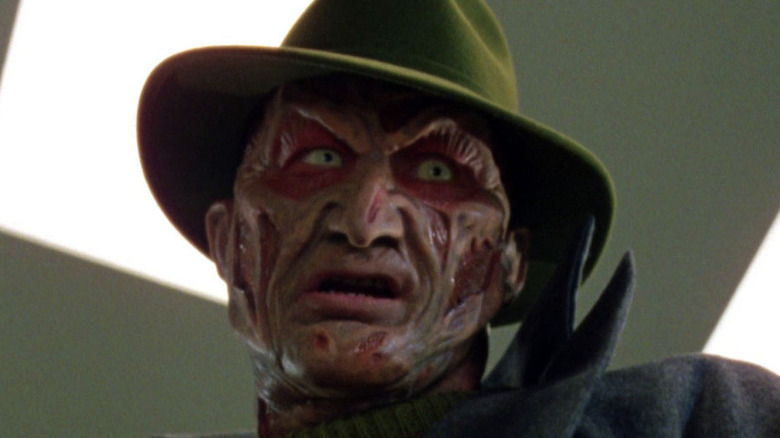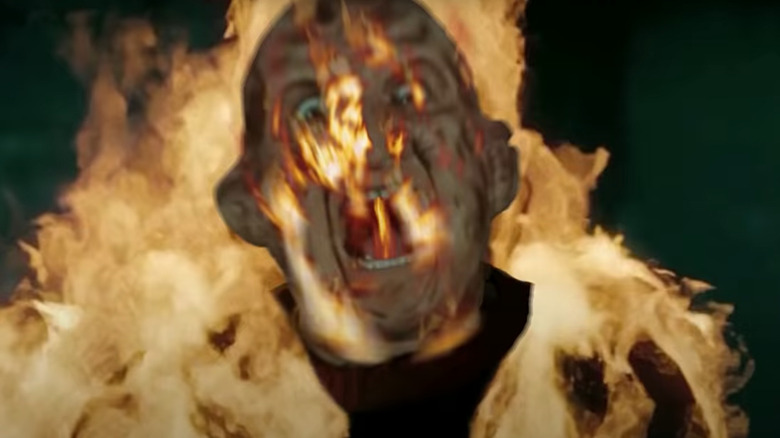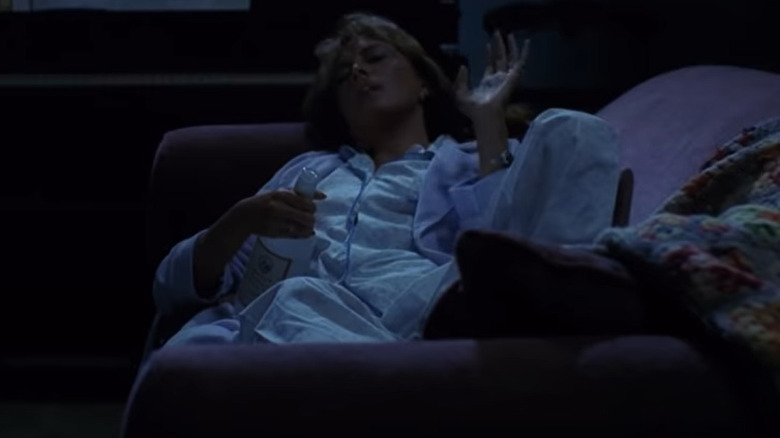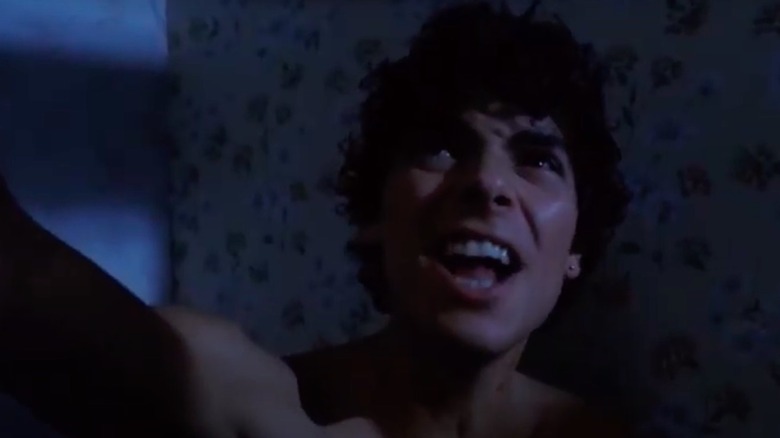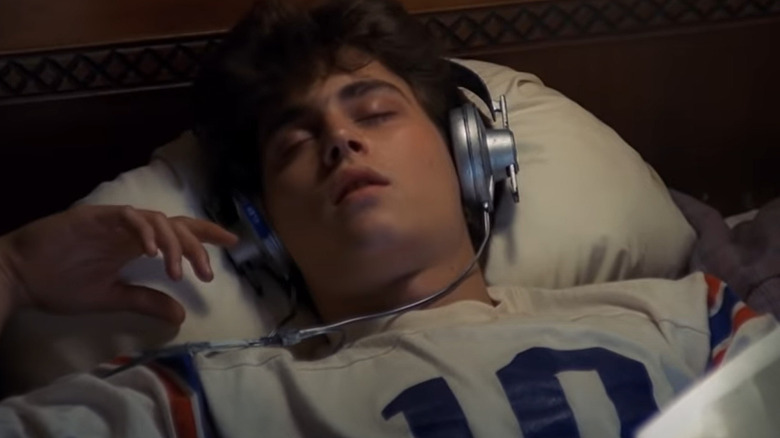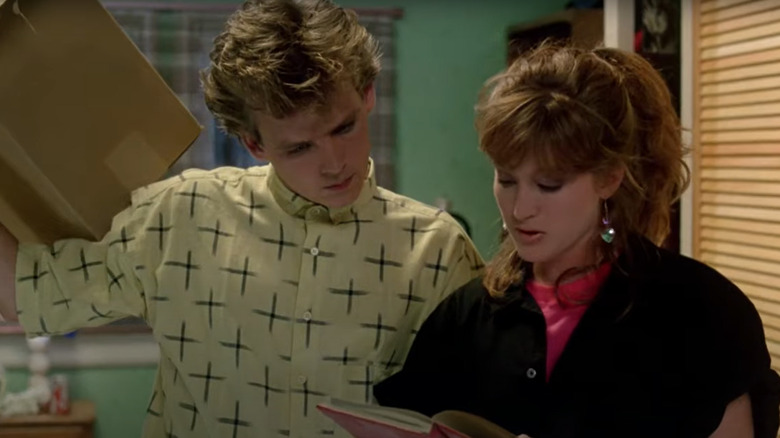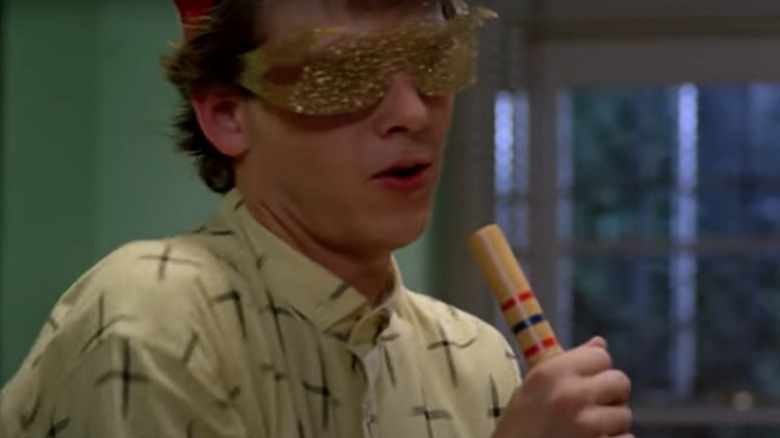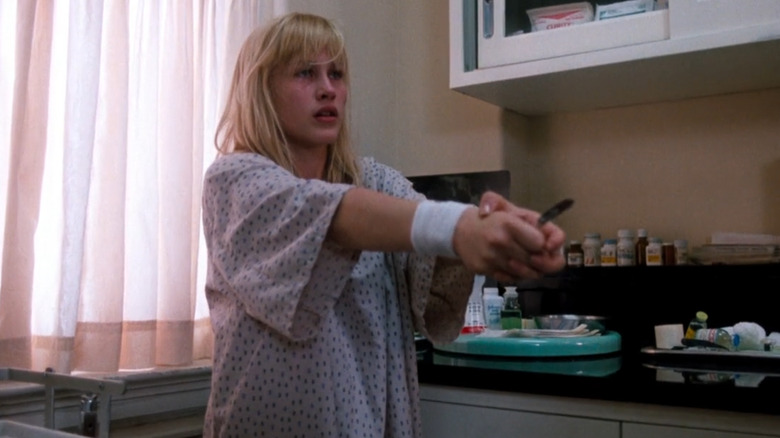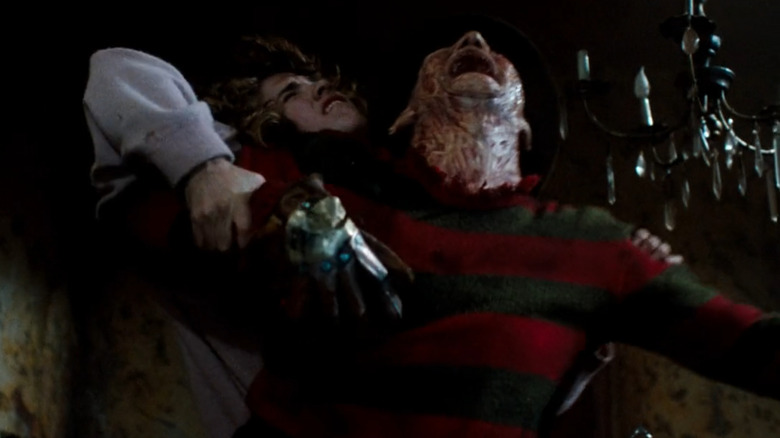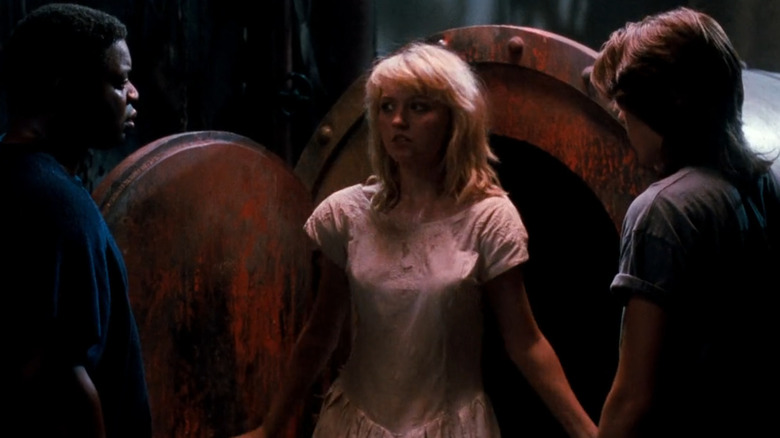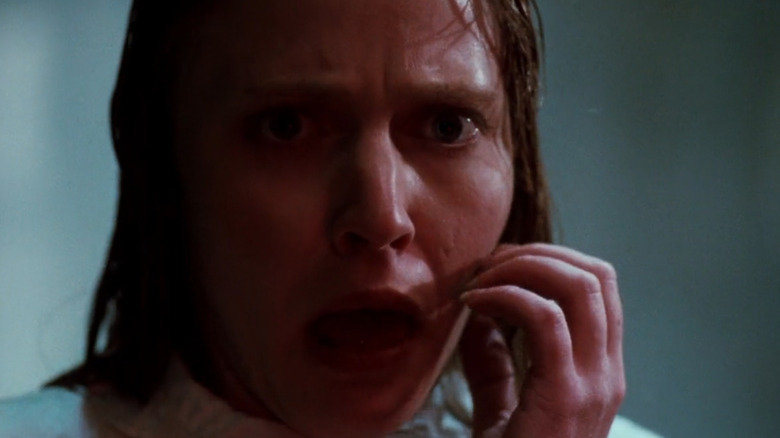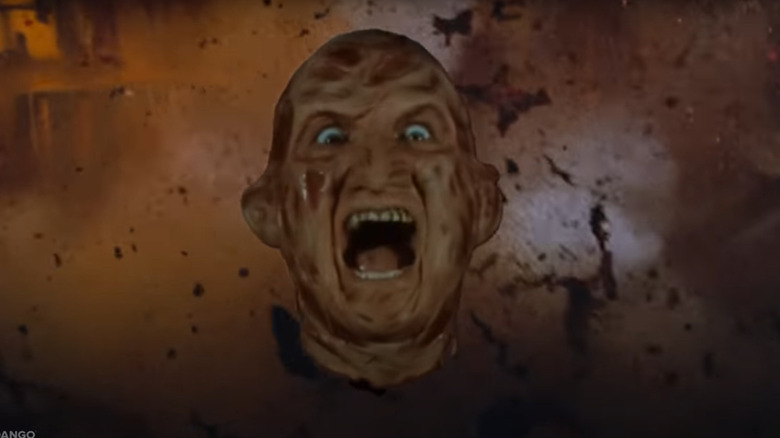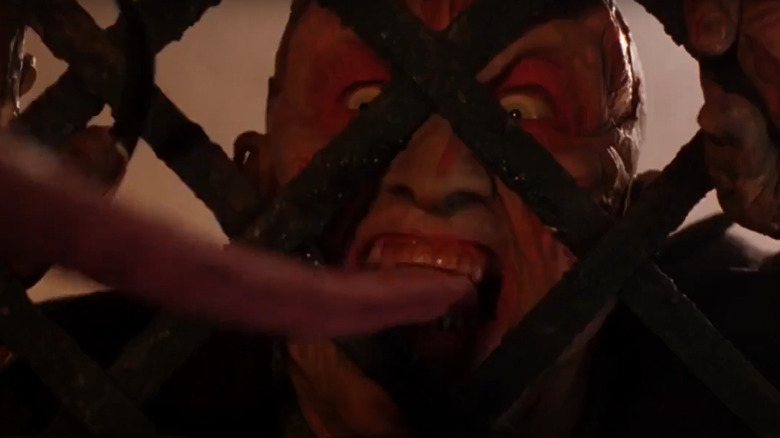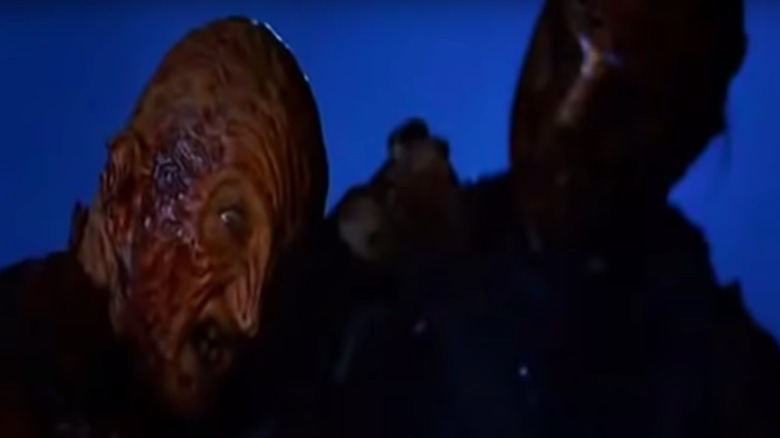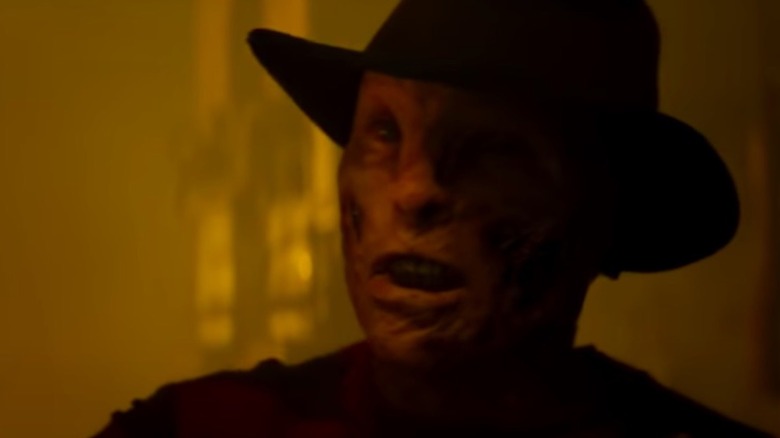Worst Decisions Nightmare On Elm Street Characters Made In The Franchise
"A Nightmare On Elm Street" tends to get lumped in with "Friday the 13th," "Halloween," and the other horror franchises that emerged during the slasher boom of the late 1970s and 1980s. However, there's an important distinction between Freddy Krueger — the supernatural big bad from "Elm Street" almost always depicted by Robert Englund — and his ultra-violent contemporaries. While Freddy assumes tangible physical form now and again, most of the time, he's an abstract concept lurking in the collective unconscious. Whereas Michael Myers and Jason Voorhees bump folks off without much style or pizzazz, Freddy stalks and slices down his prey in their dreams, where he can kill in literally any wacky way imaginable.
You know how if you die in The Matrix, you die in the real world? The same idea applies here. When Freddy shows up in your dreams and stabs you with his signature knife glove, your real-world body starts bleeding. That's why we can't really tick off reasons why specific victims should be able to outsmart Freddy and escape the same way we could if we nick picked "Halloween" or "Friday the 13th" sequels. When we dream, we're not really in control of our choices during that time, are we? Nevertheless, plenty of characters throughout the eight applicable "Nightmare" movies — especially Freddy — make wildly foolish choices on a routine basis. Let's look at the worst offenders.
The parents of Springwood burn Fred Krueger alive
Knowing what they know today, our guess is that the parents of Springwood, Ohio, may express some regret for burning "The Springwood Slasher" Freddy Krueger alive after a court acquitted him for the murders of several community children. Typically, when folks form a frenzied mob with the specific intention to set a person on fire, they're already making the wrong call. In this case, by taking matters into their own hands and offing Freddy after the state declared his innocence, Springwood's parents allowed him to transform into an immortal psychic demon with virtually omnipotent power in the dream realm. Basically, they made it much easier for him to hack up the rest of their children.
There's a pretty clear moral about vigilante violence baked into Freddy's origin story. Maybe it gives the halfwits involved a quick boost of emotional validation, but its long-term consequences are extra disagreeable.
Nancy's mom locks her in the house
Rather than functioning as protectors or caregivers, adults in "Elm Street" movies tend to make matters worse by refusing to take their kids' life-or-death situations seriously while insisting that everything will be fine as soon as these cranky teens get a solid eight hours of sleep. During her appearances in "A Nightmare on Elm Street 3: Dream Warriors" and "A Nightmare on Elm Street 4: The Dream Master," Elaine Parker (Brooke Bundy) establishes herself as the meanest mom in the series. But in terms of sheer harm done, even Kristen's garbage mom can't top the original terrible parent of the "Nightmare" franchise, Marge Thompson (Ronee Blakley).
Marge — who helped hunt down and roast Freddy Krueger herself — could prevent a lot of harm by simply acknowledging that her daughter Nancy (Heather Langenkamp) might not be imagining Freddy and his mid-dream stalking. Even after Marge watches Nancy pull Freddy's hat into the real world, Marge remains a Freddy skeptic. By locking Nancy in their house to keep her from causing more mischief, Marge prevents her from warning Glen (Johnny Depp) of an impending Freddy attack, and therefore might as well have covered the walls of Glen's bedroom in blood herself. We can place some of the blame on Glen's parents for blocking Nancy's phone call, but unlike Marge, they had no reason to know better.
Rod visits Nancy, a police officer's daughter
Maybe we shouldn't be too hard on Rod (Jsu Garcia). In one of the most memorable sequences in the first "Nightmare on Elm Street," he watches helplessly as his girlfriend Tina (Amanda Wyss) spontaneously gushes blood from three inexplicable cuts across her chest, flies out of their bed, spins in the air, knocks him down, seemingly falls down the wall, and dies on the ceiling. A sight like that would distort anyone's judgment. Also, we understand wanting to talk to a friend following a traumatic incident. It's quite reasonable that Rod would want Nancy, in particular, to know that he didn't butcher Tina — his girlfriend and her best pal.
But Nancy's dad (John Saxon) is a member of the Springwood Police Department, and Rod is on the run due to his connection to a grisly murder. These circumstances should probably discourage Rod from giving Nancy a visit, but they don't, and he definitely sets himself up to get caught. It's a bad decision, but not a consequential decision. In the grand scheme of things, if Freddy can't kill Rod in jail, he can simply kill Rod in whatever other location he happens to be sleeping.
Nancy depends on narcoleptic Glen to stay awake
In his debut role as Nancy Thompson's well-meaning boyfriend, Johnny Depp launched one of the most storied Hollywood careers of his generation. As far as Glen himself goes, this dude can't be depended on for anything.
Glen doesn't fully understand or appreciate the danger of Freddy the way Nancy does. He's mostly going along to get along with Nancy's plans and doesn't consider himself at risk. Still, that's no excuse for how on not one but two occasions, Glen promises to stay awake for a brief period of time and breaks his promise by almost immediately catching Zs. This happens early in the film when he says he'll wake Nancy up if she looks like she's in trouble, and once again when he's supposed to meet her at midnight to whack Freddy with a baseball bat after she pulls him into reality. And then this happens. Way to go, Glen.
Jesse's parents move into Marge Thompson's previous home
We imagine sometime before the events depicted in 1985's "A Nightmare on Elm Street 2," a real estate agent told the Walsh family about an unbelievable deal on a three-bedroom house in a mostly quiet Ohio suburb. Had internet search engines been a thing in the 1980s, several lives would have been spared.
Is it pretty easy for us to say Mr. and Mrs. Walsh — parents of "Elm Street 2" protagonist Jesse Walsh (Mark Patton) — should've asked around town regarding this particular property. Had they done so, they might've learned more about the circumstances surrounding the death of former owner Marge Thompson, her daughter Nancy's highly unusual sleep disorder, and the mysterious deaths of a handful of Nancy's friends. Sadly, the Walshes did not ask around, so they bought the house and accidentally doomed their son to demonic possession.
Jesse's dance routine
For obvious reasons, we'd rather not get in the habit of scrutinizing what folks do by themselves behind closed doors. However, Jesse's impromptu interpretative dance and lip-sync to Fonda Rae's "Touch Me (All Night Long)" stands out as one of the most memorable scenes in a film that also includes the brutal slaughter of a naked gym coach and Freddy emerging from Jesse's toro like a xenomorph from the "Alien" franchise. In fact, Jesse's dance might be even more enduring than those scenes because we expect to see graphic violence and body horror in a slasher sequel. We don't expect to see anything as goofy as Jesse flailing around like a rhythmless dunderhead in the middle of the day when his mom and a plutonic female companion could walk in at any moment.
Jesse's "Touch Me" moment might be silly, but it's also a significant moment in "Elm Street" history. While the first movie takes itself fairly seriously, the dark sense of humor the series eventually becomes known for really begins with "Elm Street 2." Throughout "Elm Street 3," Freddy tosses around morbid one-liners as if it's second nature, and it doesn't feel like a tonal swift, partly because the prior sequel gave this franchise permission to lighten up a little.
Any doctor writing a prescription for sleeping pills
Because he spends the overwhelming majority of his time in dreams, Freddy Krueger doesn't exist in the same way we conventionally think of existing. That makes him difficult to pin down and quantify, creating a nebulous space for folks who are already ideologically opposed to combating Freddy that allows them to deny that he's a problem at all.
While some have good intentions, the physicians at the sleep disorder clinic in the first film, Dr. Neil Gordon (Craig Wasson) attempting to sedate his patients in "Elm Street 3," Kristen's garbage mom mixing pills into her daughter's water in "Elm Street 4," and even nurses in the quasi-reality of "New Nightmare" all condemn children and teenagers to painful, cruel deaths at the hands of a spectral madman.
Giving people drugs to make them sleepy when the omnipresent threat is killing people in their sleep is a very bad idea. Forward-thinking scientists would be searching for a means for people to fight Freddy while they're awake, thereby effectively neutralizing his power, but let's not get too sidetracked.
Freddy turns his back on Nancy
Is Freddy Krueger smart? No doubt he's evil, supremely powerful in the dream world, and quick with a quip. But in dreams, Freddy can do literally anything whenever he wants, and the best his prey can do to fight back is develop Dream Warrior powers that rarely prove meaningfully useful. Freddy holds all the cards in all these movies, but he always loses. Before the end of every "Elm Street," one or more of his intended victims turn the tables on him, and the next thing Freddy knows, he's dead and needs to resurrect himself at the beginning of the next sequel.
At the ending of 1987's "Elm Street 3," Freddy manages to trick Nancy into dropping her guard and slides his finger knives directly into her lower back. Then — without checking to make sure his greatest enemy, the woman who vanquished him in the past, is actually dead — Freddy turns his attention to Kristen (Patricia Arquette). It's not something a smart person would do. Afterward, Nancy musters up the strength to get back to her feet, grabs Freddy's arm, and plunges his blades into his own gut. Soon after, Freddy explodes like a chump. Freddy may be a horror icon, but boy does he ever drop the ball on this one.
Joey and Kincaid obviously should've listened to Kristen
The first time someone tells you, "The literal boogeyman will kill you in your dream if you go to sleep," it's very reasonable to dismiss that person as experiencing a delusional episode of some kind. The fourth time someone tells you the same thing — especially after you've personally encountered this boogeyman and barely lived to tell the tale — maybe it's time to pay attention?
Some folks are bigger fans of 1988's "A Nightmare on Elm Street 4: The Dream Master" than others. With all due respect to prolific horror actor Tuesday Knight, she's an awkward replacement for Patricia Arquette, whose grounded performance as Kristen Parker helps keep "Elm Street 3" from getting lost in its own madcap phantasmagoria. Worse yet, when Kristen's dreams start including little kids jumping rope and singing the "One, two, Freddy's coming for you" song — which is always a harbinger of Freddy's return — she warns Kincaid (Ken Sagoes) and Joey (Rodney Eastman), her companions from "Elm Street 3." Despite their harrowing experiences at the Westin Hills Psychiatric Hospital, they brush her off without much consideration.
Unsurprisingly, Kincaid and Joey are both notches on Freddy's belt before "Elm Street 4" hits the 30-minute mark. Perhaps if they had listened to a completely credible warning, they might've made it to "Elm Street 5?" Who can say?
Kristen pulls Alice into her dream
Around 1988, New Line may have correctly noticed that the target audience for films about an undead serial killer burn victim who tells jokes isn't overly concerned with plausibility. That might explain why after "Elm Street 3," the mythology gets a little janky. For instance, in "Elm Street 4," after Freddy hacks up Kincaid and Joey, we're told Kristen is the only still-living offspring of anyone involved with the angry mob that brought about Freddy's fiery demise years earlier. It's implied that once Freddy kills Kristen, he won't have a connection to any new targets unless Kristen pulls someone into her dream beforehand.
Where did these rules come from? Why are we only hearing about them now? Are we stupid for asking? Shortly after emphatically declaring she wouldn't, Kristen summons her school chum Alice (Lisa Wilcox) into her dream. Freddy kills Kristen, Lisa takes over as the Final Girl, and so commences the remaining events of "Elm Street 4," which lead into the truly wackadoo 1989 installment, "A Nightmare on Elm Street 5: The Dream Child."
In her last deliberate act, Kristen — depicted as pragmatic and courageous up until this point — throws her friend under the bus and gets a whole slew of people killed. It's a crappy decision.
Freddy doesn't run away from an honest fight
Released in 1991, "Freddy's Dead: The Final Nightmare" is technically the worst-reviewed of the original "Elm Street" series, and maybe the critics raise some valid concerns. This film piles extra layers onto Freddy's already overdeveloped origin story and leans heavily on gimmicks and mostly terrible celebrity cameos. In its defense, "Freddy's Dead" is the one where Freddy basically kills Breckin Meyer with a Nintendo Power Glove, and nothing's more 1991 than that.
It's also the one where Freddy faces off against his daughter Maggie — a new addition to the mythology played by Lisa Zane — in a straight-ahead fight, where his usual powers over the dream environment are not a factor. Maggie outmaneuvers and overpowers her estranged father, and the encounter ends with a stick of dynamite scattering little bits of Freddy all over the building.
Clearly, Freddy should be more mindful of his limitations and run away from any fight that doesn't take place in a dream. It's okay if Freddy's clearly a coward — he's the villain of the story, and being cowardly is what villains do.
Freddy's choice of weapon
Dialing back the cartoony elements that "Freddy's Dead" stretch beyond their breaking points, 1994's "Wes Craven's New Nightmare" temporarily ends the "Elm Street" series on a meta note while returning Freddy to his thoroughly unfunny baseline.
Perhaps not coincidently, Freddy's plans in "New Nightmare" only collapse when he reverts to the type of over-the-top antics associated with previous sequels. Heather Langenkamp (playing herself) interrupts Freddy just as he's on the cusp of eating her son Dylan (Miko Hughes). To dispatch the erstwhile Nancy, Freddy extends his tongue into an indefinite length, wraps it around his target, and commences squeezing the air out of her as if his tongue was a boa constrictor.
Dylan — who Freddy apparently forgot was still completely alive — grabs Freddy's tongue, pins it to the ground with his foot, and stabs it with a nearby knife. Obviously, this leaves Freddy in unimaginable pain. Soon after, the ostensibly unstoppable supernatural badass has been defeated by a 120-pound actor and a young child.
Freddy takes Jason Voorhees for a mark
At the beginning of 2003's "Freddy vs. Jason," Freddy's stuck in hell and can no longer malevolently hop around the collective subconscious. Getting back in the proverbial saddle entails resurrecting Jason Voorhees (Ken Kirzinger) and encouraging the monster — sometimes described as a "pissed off goalie" — to slaughter as many bright-eyed Springwood youths as possible.
The plan works for a little while. However, the title of the film itself tells us that Freddy's attempt to boss Jason around ultimately does not pan out — and may even lead to the onetime Dream Master's undoing by the end of the movie. Considering Freddy's history of repeated defeat at the hands of teenage girls, what made him think he could control an unkillable omega-zombie with a machete? By this point in his career, you would think Freddy might've learned some humility or sense of his limitations.
Anyone who does anything in the 2010 remake
There are no films in the "Elm Street" series that qualify as untouchable sacrosanct masterpieces. Even the three movies widely considered the franchise's high points — the first one, "Elm Street 3," and "New Nightmare" — are loaded with questionable acting and hammy dialogue. And while nobody can replace Robert Englund's version of Freddy, plenty of actors could summon up a new take on the character. After all, there's quite a bit of precedent for multiple actors delivering unique iterations of the same iconic genre villain — just look at the Joker. Hollywood should be able to produce a worthy "Elm Street" reboot without much of a problem.
So how the heck did so much go wrong with 2010's "A Nightmare on Elm Street" starring Jackie Earle Haley? Plenty of folks, including Robert Englund, have provided thoughts on the matter. We'd add that while not every idea in the original "Nightmare" series is good — in fact, some are downright absurd — it always has ideas. The 2010 "Nightmare" does not have ideas — it has edgelord nonsense, which is not the same thing as ideas, nor is it scary.
Meanwhile, in "Elm Street 4," Freddy accosts a victim while she's lifting weights, breaks her arms, turns her into a bug, then squishes her — whatever you make of it, it's indisputably an idea.
